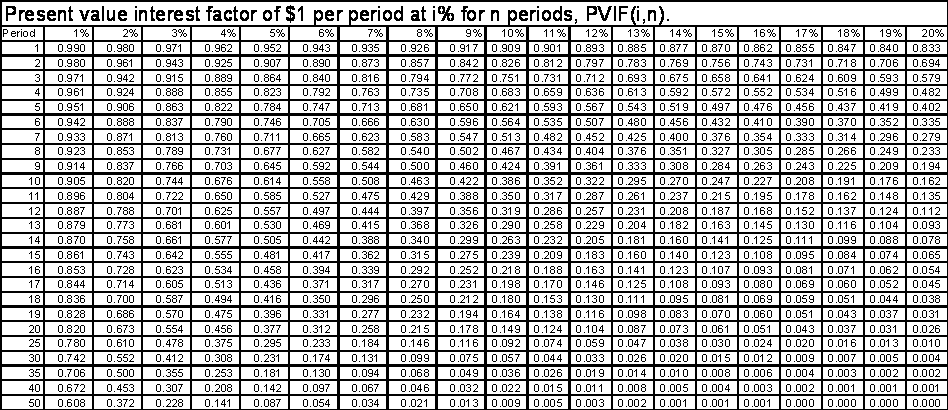Genesis Management Services Pty Ltd gmservices.com.au
genesis
SERVICES
EXPERIENCE
UNIT 12. DISCOUNTED CASH FLOW
Discounted Cash Flow always sounds complicated to students but in reality it is a very simple yet powerful management tool.
The starting point is to revise what we understand about interest.
If we invest $1 for a year at 10% we would expect to earn interest of 10 cents and have the $1 plus the interest returned to us at the end of that year. The formula for this transaction is as follows:
$1 x 110 = 110 = $1.10
100 100
Now if we wanted to invest less than $1 so that we ended up with a total of $1 at the end of the year after earning 10% interest, we would have to invest 90.9 cents calculated as follows:
$1 x 100 = 90.9 cents
110
Notice how the numerator and denominator have been reversed.
Have a look now at a discount table (at end of this paper) and look up the 10% interest rate column for one year. See the answer is .909 which corresponds with our answer above of 90.9 cents. What we are saying here is that if we want to earn a dollar in one year's time, assuming an interest rate of 10%, we will have to invest 90.9 cents to start with.
At this point we introduce some jargon called "present value". We say that the present value of $1 (the dollar that will be received in one year's time including interest at 10%) is 90.9 cents.
What would the present value of $1 in two year's time at 10% be? Look up the table and see that it will be .826 or 82.6 cents. Thus 82.6 cents would compound to $1 in two year's time at an interest rate of 10% per annum. This can be proved as follows:
First Year Interest 10% of 82.6 cents = 8.260 cents
Second Year Interest 10% of 90.86 cents = 9.086 cents
Total Interest for Two Years 17.346 cents
Plus Initial Investment 82.600 cents
Target Future Value 99.946 cents
There has been some rounding off in these calculations but the answer is close enough to $1.
Another way of proving this is as follows:
0.909 x 100 = 0.826
110
The figures in the table below have been calculated in this way.
Now what does all this mean in plain language?
If you look at the 10% column you will see that $1 is worth less to us for each year that goes by. In other words $1 in one year's time is worth more to us today than $1 in two year's time or more.
If we have two projects that promise us the same return in total dollars, but one brings the money in one year whilst the other takes two years, we will obviously go for the first.
Normally however when we are trying to choose between different investment alternatives we have different cash flows over different time periods. We have to look at each of the figures for each year and "discount" them in accordance with the interest rate figures in the discount tables.
The following example illustrates the arithmetical approach involved:
Present Value
Capital outlay, $100,000; Cost of Capital, 10%, Salvage Value $5,000.
Cash flow Year 1 $ 32,000
2 28,000
3 24,000
4 20,000
5 16,000
6 5,000
Present Value at 10%
|
Outflow |
Inflow |
Discount |
Outflow |
Inflow |
|
|
Start of Year 1 |
100000 |
|
1000 |
100000 |
|
|
End of Year 1 |
|
32000 |
.909 |
29088 |
|
|
2 |
|
28000 |
.826 |
23128 |
|
|
3 |
|
24000 |
.751 |
18024 |
|
|
4 |
|
20000 |
.683 |
13660 |
|
|
5 |
|
16000 |
.621 |
9936 |
|
|
6 |
|
5000 |
.565 |
2825 |
|
|
|
|
|
|
|
|
|
Total |
|
100000 |
125000 |
100000 |
96661 |
If the present value (discounted) total inflow were $100,000 it would have equalled the original investment. We can conclude therefore that the true rate of return (interest) would be less than 10%. Look up the tables for lower rates and see what rate comes closest to giving us an answer of $100,000 present value. This interest rate is called the "internal rate of return".
If you are used to working with a computer and spreadsheet programmes you can find the internal rate of return (IRR) by using a special formula built into the programme. By using this formula across a range of cash flow figures the computer is able to try out different rates and then find the exact one, which is called the IRR.

Copyright © Bill Wright 1994